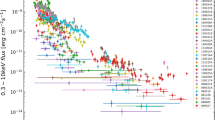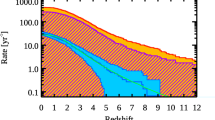Abstract
We use the correlation relation between the energy emitted by the GRBs in their prompt phases and the X-ray afterglow fluxes, in an effort to constrain cosmological parameters and aiming to construct a Hubble diagram at high redshifts, i.e. beyond those found with Type Ia supernovae.
We use a sample of 126 Swift GRBs, that we have selected among more than 800 long bursts observed until April 2015. The selection is based on a few observational constraints: GRB flux higher than \(0.4~\mbox{photons}\,\mbox{cm}^{-2}\,\mbox{s}^{-1}\) in the band 15–150 keV; spectrum fitted with simple power law; redshift accurately known and given; and X-ray afterglow observed and flux measured.
The statistical method of maximum likelihood is then used to determine the best cosmological parameters (\(\varOmega_{M}\), \(\varOmega_{\varLambda }\)) that give the best correlation for two relations: (a) the Amati relation (between intrinsic spectral peak energy \(E_{p,i}\) and the equivalent isotropic energy); (b) the Dainotti relation, namely between the X-ray afterglow luminosity \(L_{X}\) and the break time \(T_{a}\), which is observed in the X-ray flux FX.
Although the number of GRBs with high redshifts is rather small, and despite the notable dispersion found in the data, the results we have obtained are quite encouraging and promising. The results obtained using the Amati relation are close to those obtained using the Type Ia supernovae, and they appear to indicate a universe dominated by dark energy. However, those obtained with the correlation between the break time and the X-ray afterglow luminosity is consistent with the findings of the WMAP study of the cosmic microwave background radiation, and they seem to indicate a de Sitter-Einstein universe dominated by matter.


















Similar content being viewed by others
References
Amati, L.: Chin. J. Astron. Astrophys. Suppl. 3, 455 (2003). astro-ph/0405318
Amati, L.: Mon. Not. R. Astron. Soc. 372, 233 (2006). doi:10.1111/j.1365-2966.2006.10840.x
Amati, L., Della Valle, M.: Int. J. Mod. Phys. D 22, 1330028 (2013). 1310.3141. doi:10.1142/S0218271813300280
Amati, L., Frontera, F., Guidorzi, C.: Astron. Astrophys. 508, 173 (2009). 0907.0384. doi:10.1051/0004-6361/200912788
Amati, L., Frontera, F., Tavani, M., Zand, J.J.M., Antonelli, A., Costa, E., Feroci, M., Guidorzi, C., Heise, J., Masetti, N., Montanari, E., Nicastro, L., Palazzi, E., Pian, E., Piro, L., Soffitta, P.: Astron. Astrophys. 390, 81 (2002). doi:10.1051/0004-6361:20020722
Amati, L., Guidorzi, C., Frontera, F., Della Valle, M., Finelli, F., Landi, R., Montanari, E.: Mon. Not. R. Astron. Soc. 391, 577 (2008). 0805.0377. doi:10.1111/j.1365-2966.2008.13943.x
Azzam, W.J., Alothman, M.J.: Adv. Space Res. 38, 1303 (2006a). doi:10.1016/j.asr.2004.12.019
Azzam, W.J., Alothman, M.J.: Nuovo Cimento B 121, 1431 (2006b). doi:10.1393/ncb/i2007-10270-5
Cardone, V.F., Capozziello, S., Dainotti, M.G.: Mon. Not. R. Astron. Soc. 400, 775 (2009). 0901.3194
Cardone, V.F., Perillo, M., Capozziello, S.: Mon. Not. R. Astron. Soc. 417, 1672 (2011). 1105.1122
Cardone, V.F., Dainotti, M.G., Capozziello, S., Willingale, R.: Mon. Not. R. Astron. Soc. 408, 1181 (2010). 1005.0122. doi:10.1111/j.1365-2966.2010.17197.x
Coward, D.: New Astron. Rev. 51, 539 (2007). astro-ph/0702704. doi:10.1016/j.newar.2007.03.003
D’Agostini, G.: physics/0511182 (2005)
Dai, Z.G., Liang, E.W., Xu, D.: Astrophys. J. Lett. 612, 101 (2004). astro-ph/0407497. doi:10.1086/424694
Daigne, F., Mochkovitch, R.: Astron. Astrophys. 465, 1 (2007). 0707.0931. doi:10.1051/0004-6361:20066080
Dainotti, M.G., Cardone, V.F., Capozziello, S.: Mon. Not. R. Astron. Soc. 391, 79 (2008). 0809.1389
Dainotti, M.G., Ostrowski, M., Willingale, R.: Mon. Not. R. Astron. Soc. 418, 2202 (2011). 1103.1138. doi:10.1111/j.1365-2966.2011.19433.x
Dainotti, M.G., Willingale, R., Capozziello, S., Fabrizio Cardone, V., Ostrowski, M.: Astrophys. J. Lett. 722, 215 (2010). 1009.1663. doi:10.1088/2041-8205/722/2/L215
Dainotti, M.G., Petrosian, V., Singal, J., Ostrowski, M.: Astrophys. J. 774, 157 (2013a). 1307.7297
Dainotti, M.G., Cardone, V.F., Piedipalumbo, E., Capozziello, S.: Mon. Not. R. Astron. Soc. 436, 82 (2013b). 1308.1918. doi:10.1093/mnras/stt1516
Dainotti, M.G., Del Vecchio, R., Shigehiro, N., Capozziello, S.: Astrophys. J. 800, 31 (2015a). 1412.3969
Dainotti, M., Petrosian, V., Willingale, R., O’Brien, P., Ostrowski, M., Nagataki, S.: Mon. Not. R. Astron. Soc. 451, 3898 (2015b). 1506.00702. doi:10.1093/mnras/stv1229
Dainotti, M., Postnikov, S., Hernandez, X., Ostrowski, M.: 1604.06840 (2016)
D’Avanzo, P., Salvaterra, R., Sbarufatti, B., Nava, L., Melandri, A., Bernardini, M.G., Campana, S., Covino, S., Fugazza, D., Ghirlanda, G., Ghisellini, G., Parola, V.L., Perri, M., Vergani, S.D., Tagliaferri, G.: Mon. Not. R. Astron. Soc. 425, 506 (2012). 1206.2357. doi:10.1111/j.1365-2966.2012.21489.x
Dermer, C.D.: Astrophys. Space Sci. 309, 127 (2007). astro-ph/0610195. doi:10.1007/s10509-007-9417-8
Evans, P.A., Beardmore, A.P., Page, K.L., Osborne, J.P., O’Brien, P.T., Willingale, R., Starling, R.L.C., Burrows, D.N., Godet, O., Vetere, L., Racusin, J., Goad, M.R., Wiersema, K., Angelini, L., Capalbi, M., Chincarini, G., Gehrels, N., Kennea, J.A., Margutti, R., Morris, D.C., Mountford, C.J., Pagani, C., Perri, M., Romano, P., Tanvir, N.: Mon. Not. R. Astron. Soc. 397, 1177 (2009). 0812.3662. doi:10.1111/j.1365-2966.2009.14913.x
Fenimore, E.E., Ramirez-Ruiz, E.: astro-ph/0004176 (2000)
Ghirlanda, G., Ghisellini, G., Lazzati, D.: Astrophys. J. 616, 331 (2004). doi:10.1086/424913
Ghirlanda, G., Nava, L., Ghisellini, G.: Astron. Astrophys. 511, 43 (2010). 0908.2807. doi:10.1051/0004-6361/200913134
Ghirlanda, G., Ghisellini, G., Lazzati, D., Firmani, C.: Astrophys. J. Lett. 613, 13 (2004). astro-ph/0408350. doi:10.1086/424915
Ghirlanda, G., Ghisellini, G., Firmani, C., Nava, L., Tavecchio, F., Lazzati, D.: Astron. Astrophys. 452, 839 (2006). astro-ph/0511559. doi:10.1051/0004-6361:20054544
Ghirlanda, G., Salvaterra, R., Ghisellini, G., Mereghetti, S., Tagliaferri, G., Campana, S., Osborne, J.P., O’Brien, P., Tanvir, N., Willingale, D., Amati, L., Basa, S., Bernardini, M.G., Burlon, D., Covino, S., D’Avanzo, P., Frontera, F., Götz, D., Melandri, A., Nava, L., Piro, L., Vergani, S.D.: Mon. Not. R. Astron. Soc. 448, 2514 (2015). 1502.02676. doi:10.1093/mnras/stv183
Hopkins, A.M., Beacom, J.F.: Astrophys. J. 651, 142 (2006). astro-ph/0601463. doi:10.1086/506610
Jakobsson, P., Levan, A., Fynbo, J.P.U., Priddey, R., Hjorth, J., Tanvir, N., Watson, D., Jensen, B.L., Sollerman, J., Natarajan, P., Gorosabel, J., Castro Cerón, J.M., Pedersen, K., Pursimo, T., Árnadóttir, A.S., Castro-Tirado, A.J., Davis, C.J., Deeg, H.J., Fiuza, D.A., Mikolaitis, S., Sousa, S.G.: Astron. Astrophys. 447, 897 (2006). astro-ph/0509888. doi:10.1051/0004-6361:20054287
Kistler, M.D., Yüksel, H., Beacom, J.F., Stanek, K.Z.: Astrophys. J. Lett. 673, 119 (2008). 0709.0381
Kodama, Y., Yonetoku, D., Murakami, T., Tanabe, S., Tsutsui, R., Nakamura, T.: Mon. Not. R. Astron. Soc. 391, 1 (2008). 0802.3428
Liang, E., Zhang, B.: Astrophys. J. 633, 611 (2005). astro-ph/504404. doi:10.1086/491594
Mao, J.: Astrophys. J. 717, 140 (2010). 1005.1876
Mao, S., Mo, H.J.: Astron. Astrophys. 339, 1 (1998). astro-ph/9808342
Margutti, R., Zaninoni, E., Bernardini, M.G., Chincarini, G., Pasotti, F., Guidorzi, C., Angelini, L., Burrows, D.N., Capalbi, M., Evans, P.A., Gehrels, N., Kennea, J., Mangano, V., Moretti, A., Nousek, J., Osborne, J.P., Page, K.L., Perri, M., Racusin, J., Romano, P., Sbarufatti, B., Stafford, S., Stamatikos, M.: Mon. Not. R. Astron. Soc. 428, 729 (2013). 1203.1059. doi:10.1093/mnras/sts066
Martin, B.: Statistics for Physical Sciences: An Introduction. Academic Press, London (2012)
Nakar, E., Piran, T.: Mon. Not. R. Astron. Soc. 360, 73 (2005). astro-ph/0412232
Natarajan, P., Albanna, B., Hjorth, J., Ramirez-Ruiz, E., Tanvir, N., Wijers, R.: Mon. Not. R. Astron. Soc. 364, 8 (2005). astro-ph/0505496. doi:10.1111/j.1745-3933.2005.00094.x
Norris, J.P., Marani, G.F., Bonnell, J.T.: Astrophys. J. 534, 248 (2000). astro-ph/9903233. doi:10.1086/308725
Petrosian, V., Kitanidis, E., Kocevski, D.: Astrophys. J. 806, 44 (2015). 1504.01414
Porciani, C., Madau, P.: Astrophys. J. 548, 522 (2001). astro-ph/0008294. doi:10.1086/319027
Riess, A.G., Strolger, L.-G., Tonry, J., Casertano, S., Ferguson, H.C., Mobasher, B., Challis, P., Filippenko, A.V., Jha, S., Li, W., Chornock, R., Kirshner, R.P., Leibundgut, B., Dickinson, M., Livio, M., Giavalisco, M., Steidel, C.C., Benítez, T., Tsvetanov, Z.: Astrophys. J. 607, 665 (2004). astro-ph/0402512. doi:10.1086/383612
Sakamoto, T., Barthelmy, S.D., Baumgartner, W.H., Cummings, J.R., Fenimore, E.E., Gehrels, N., Krimm, H.A., Markwardt, C.B., Palmer, D.M., Parsons, A.M., Sato, G., Stamatikos, M., Tueller, J., Ukwatta, T.N., Zhang, B.: Astrophys. J. Suppl. Ser. 195, 2 (2011). 1104.4689. doi:10.1088/0067-0049/195/1/2
Saporta, G.: Probabilitès, Analyse des Donnèes et Statistique, 2nd edn. Editions Technip, Paris (2011)
Schaefer, B.E.: Astrophys. J. Lett. 583, 67 (2003). astro-ph/0212445. doi:10.1086/368104
Schaefer, B.E.: Astrophys. J. 660, 16 (2007). astro-ph/0612285. doi:10.1086/511742
Sultana, J., Kazanas, D., Fukumura, K.: Astrophys. J. 758, 32 (2012). 1208.1680. doi:10.1088/0004-637X/758/1/32
Totani, T.: Astrophys. J. Lett. 486, 71 (1997). astro-ph/9707051. doi:10.1086/310853
van Eerten, H.J.: Mon. Not. R. Astron. Soc. 445, 2414 (2014). 1404.0283. doi:10.1093/mnras/stu1921
Wang, F.Y., Dai, Z.G., Liang, E.W.: New Astron. Rev. 67, 1 (2015). 1504.00735. doi:10.1016/j.newar.2015.03.001
Wang, J.S., Wang, F.Y., Cheng, K.S., Dai, Z.G.: Astron. Astrophys. 585, 68 (2016). 1509.08558. doi:10.1051/0004-6361/201526485
Wei, J.-J., Wu, X.-F., Melia, F.: Astrophys. J. 772, 43 (2013). 1301.0894. doi:10.1088/0004-637X/772/1/43
Wijers, R.A.M.J., Bloom, J.S., Bagla, J.S., Natarajan, P.: Mon. Not. R. Astron. Soc. 294, 13 (1998). astro-ph/9708183. doi:10.1046/j.1365-8711.1998.01328.x
Willingale, R., O’Brien, P.T., Osborne, J.P., Godet, O., Page, K.L., Goad, M.R., Burrows, D.N., Zhang, B., Rol, E., Gehrels, N., Chincarini, G.: Astrophys. J. 662, 1093 (2007). astro-ph/0612031. doi:10.1086/517989
Xu, D., Dai, Z.G., Liang, E.W.: Astrophys. J. 633, 603 (2005). astro-ph/0501458. doi:10.1086/466509
Yonetoku, D., Murakami, T., Nakamura, T., Yamazaki, R., Inoue, A.K., Ioka, K.: Astrophys. J. 609, 935 (2004). arXiv:astro-ph/0309217. doi:10.1086/421285
Yüksel, H., Kistler, M.D.: Phys. Rev. D 75(8), 083004 (2007). astro-ph/0610481
Zaninoni, E., Bernardini, M.G., Margutti, R., Amati, L.: Mon. Not. R. Astron. Soc. 455, 1375 (2016). 1510.05673
Zitouni, H., Guessoum, N., Azzam, W.J.: Astrophys. Space Sci. 351, 267 (2014). doi:10.1007/s10509-014-1839-5
Acknowledgements
The authors gratefully acknowledge the use of the online Swift/BAT table compiled by Taka Sakamoto and Scott D. Barthelmy. We thank the referee for very useful comments, which led to significant improvements of the paper.
Author information
Authors and Affiliations
Corresponding author
Rights and permissions
About this article
Cite this article
Zitouni, H., Guessoum, N. & Azzam, W.J. Determination of cosmological parameters from gamma ray burst characteristics and afterglow correlations. Astrophys Space Sci 361, 383 (2016). https://doi.org/10.1007/s10509-016-2969-8
Received:
Accepted:
Published:
DOI: https://doi.org/10.1007/s10509-016-2969-8




